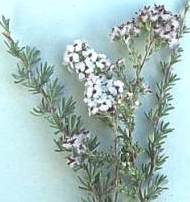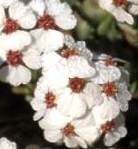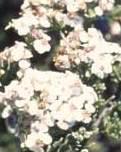Eriocephalus africanus
Eriocephalus africanus L.
Family: Asteraceae
Common names: wild rosemary (Eng.), wilderoosmaryn, kapokbos (Afr.)
Introduction
Wild rosemary is one of the shrubs that most people in the Cape know because it is so common in the veld and easy to identify with its thin, grey leaves, which smell like Vicks when crushed. It is also a well-known medicinal plant and an excellent shrub for the waterwise garden.

Description
Description
Along its wide distribution Eriocephalus africanus is very variable, especially when comparing plants growing in the salty air along the coast with those growing under much drier conditions inland. In general, they all form bushy evergreen shrubs up to 1 metre with a silvery, grey appearance.
Looking at the leaves that are arranged in tufts along the branches, it is easy to see a number of features that help the plant to survive with little water. Special features include the grey leaf colour which reflects sunlight and thereby reduces leaf temperature. The minute, silvery hairs covering the leaves trap moisture and thus reduce transpiration. The small, needle-shaped leaves are another adaptation that limits water loss. The aromatic oils are also thought to help reduce water loss. Shrubs growing on the coast have succulent leaves, whereas those growing away from the coast have thinner, less succulent leaves.

Flowering times vary, but the best displays are in winter when the whole shrub is covered in small, white flowers. Typical of the family Asteraceae, the flowers are a composition of 2-3 showy white ray florets on the outside and purple disc florets in the centre.

On warm days many bees are attracted to the flowers, seeking their small amounts of nectar. Soon after flowering, fruits are formed that are covered in long, white hairs. These attractive, fluffy seed heads look like cotton wool or snow, which gave Eriocephalus the common name kapokbos in Afrikaans. (Kapok refers to snow).

Conservation Status
Status
This is a common plant and not threatened.
Distribution and habitat
Distribution description
Eriocephalus africanus is found mostly on clay and granite slopes throughout the Western Cape, Eastern Cape and Namaqualand.
Derivation of name and historical aspects
History
In southern Africa there are 34 species of Eriocephalus, all with woolly fruits.
Uses
Use
Wild rosemary has traditionally been used as a medicine for many ailments like coughs and colds, flatulence and colic, as a diuretic and a diaphoretic. A tea is usually made with 1 cup of boiling water and a sprig of wild rosemary. In her book on indigenous herbs, Margaret Roberts mentions that wild rosemary seems to have similar qualities to ordinary rosemary as both have an invigorating effect on the skin and hair. She suggests boiling springs of wild rosemary (1 measure of twigs and flowers to 2 measures of water) for 15 minutes and when cooled to add it to the bath or to use as a hair growth stimulant and conditioner. Wild rosemary can also be used for cooking, in sachets and pot-pourris.

Growing Eriocephalus africanus
Grow
Eriocephalus prefers full sun and well drained soils. In the western Cape it is best to plant during the wet winter months so that the plants can establish themselves before the dry summer. Wild rosemary is fairly hardy and will grow in most gardens throughout the country.
Mass plantings of Eriocephalus flowering in winter are very beautiful, but they also make striking combinations in smaller groups planted with Aloe arborescens, Metalasia muricata (blombos) Coleonema album (confetti bush), Melianthus major (kruitjie-roer-my-nie) and restios. The shrubs can be pruned lightly to encourage bushy growth, to shape into a hedge or even a ball. The root system is well developed with a taproot that can penetrate the soil to a depth of 6 m, and lateral roots that extend about 2 m around the plant and are closer to the surface. This extensive root system makes Eriocephalus africanus resistant to drought and able to recover from grazing by animals. New plants are easy to propagate from seed or cuttings. The seed may be sown in autumn or spring and germinates within 10 days. Eriocephalus roots easily from tip or heel cuttings taken in spring or autumn.
References
- Eliovson, S. 1973. South African wild flowers for the garden. Macmillan, Johannesburg.
- Goldblatt, P. & Manning, J. 2000. Cape Plants. A conspectus of the Cape flora of South Africa. Strelitzia 9. National Botanical Institute, Pretoria & Missouri Botanical Garden, Missouri.
- Roberts, M. 1990. Indigenous healing plants. Southern Book Publishers, Halfway House, Johannesburg.
- Van Wyk, B.E., van Oudtshoorn, B., Gericke, N., 1997, Medicinal Plants of South Africa, Briza Publications, Pretoria.
- Jordaan A.; Kruger H., 1992: Leaf surface and anatomy of two xerophytic plants from southern africa. South African Journal of Botany. 58(3): 133-138.
- Van Breda, P.A.B & Barnard, S.A. 1991, Veld Plants of the Winter Rainfall Region, Department of Agriculture and Development
Credits
Liesl van der Walt
Kirstenbosch National Botanical Garden
June 2000
Plant Attributes:
Plant Type: Shrub
SA Distribution: Eastern Cape, Northern Cape, Western Cape
Soil type: Sandy, Clay, Loam
Flowering season: Autumn, Winter, Sporadic/All year
PH: Acid, Alkaline, Neutral
Flower colour: White
Aspect: Full Sun, Morning Sun (Semi Shade), Afternoon Sun (Semi Shade)
Gardening skill: Easy
Special Features:
Horticultural zones











Rate this article
Article well written and informative
Rate this plant
Is this an interesting plant?
Login to add your Comment
Back to topNot registered yet? Click here to register.